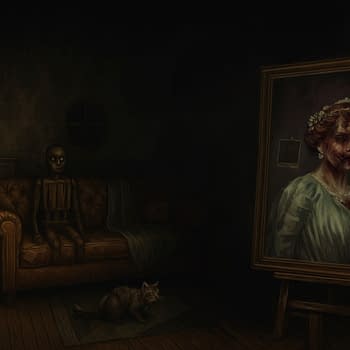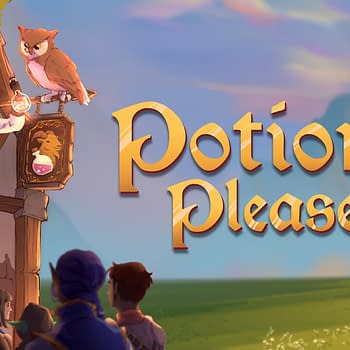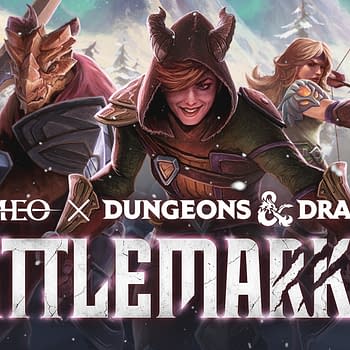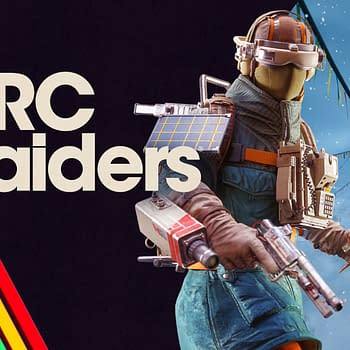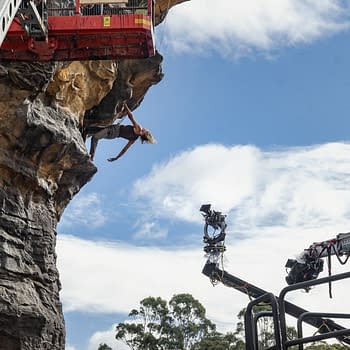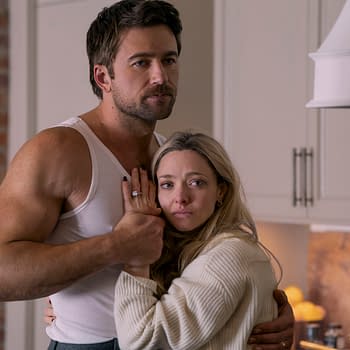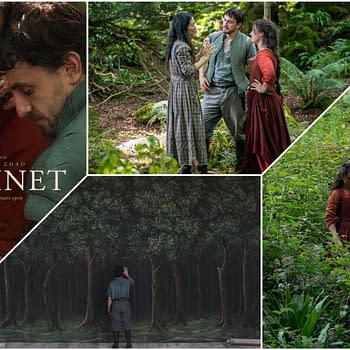Posted in: Games, Movies | Tagged: dungeons & dragons, dungeons and dragons, entertainment, interview, Lamentations of the Flame Princess, RPG Gaming, Tabletop Gaming, Zak Smith
Artist And Game Designer Zak Smith Talks About A Red And Pleasant Land
By Christopher Helton

One of the more recent controversies regarding Smith sprung up a few months ago when the Dungeons & Dragons fifth edition Players Handbook came out and Smith was credited as a consultant on it.

A Red & Pleasant Land is currently on sale in limited numbers directly from the publisher, Lamentations of the Flame Princess and will be available in stores next March. Within the first 24 hours of its availability on the publisher's webstore, the book sold more than 500 copies directly to fans. You can check out Smith's previous book Vornheim in PDF form here.
Christopher Helton: What drew you into gaming in the first place?
Zak Smith: Well when I was a kid I got into D&D because I liked Iron Maiden and setting things on fire. When I came back to it was because I liked Iron Maiden and setting things on fire and [Smith's girlfriend] Mandy [Morbid] was getting sicker, so it was harder for us to get out to see people, so we figured it'd be good to have something like a poker night here so our friends could come to us. And Satine [Phoenix] was like "I wanna play D&D again…" and the rest is on the blog.

ZS: Well let's say you read a book or see a movie and you love it, and it's really vivid to you and gets in your head–your friend asks "What's on your mind?" you go "Well there's this movie…" and if they haven't seen it too then your friend is kind of locked out of your imagination. You're thinking about tie fighters and they're just not in that world with you.
RPGs make this common experience that all the friends at the table have–they're writing it and acting in it and talking about it all at once. It's funny, it occurs to me now that it actually is like when you've worked on a movie with someone–you're like "Oh yeah, remember the chicken with the things on it…" "Oh god–fuck that chicken!" "Right?"
CH: Through your blog you have become a proponent for a style you've come to call "DIY D&D." What does that mean to you, and how has that impacted Vornheim and now Red & Pleasant Land?
ZS: Just that the game is primarily about the players and GMs inventing things, not buying stuff. In the beginning of the hobby it pretty much had to be that way–there wasn't a game you could buy so these wargamers had to make one. They cut up plastic dinosaurs with kitchen knives and glued new heads on them–that's it right there, that's the heart of the game on every level: you put something out and then other people build on it and send back something even better.
So rather than giving people completely finished game stuff which substitutes for a lack of imagination, I want to give them the bag of toys. Instead of going "Ok the goblin is here and his windmill is over here" I want to go "Here's 97 goblin windmills, use one that works and here's ways to build something I never imagined around it". I want the books I put out to sit at the table like a 6th player–ready to spit out something good when you ask them, but not in the way.
CH: What is your process for the creation of a game design, whether it ends up in a book or a blog post? At what point does your idea go from "this is an interesting thought exercise" to "this needs to be a concrete thing"? Which is more important to you as a creator, the thought exercise or the concrete thing?
ZS: I make tools because I need them. Like Kimberly Kane went through like seven wardogs (I think when the last one died she cried and smacked a guy with its carcass) and I started thinking – I need a table for all these poor dogs – we should have it so, when you roll up in a town and want to buy a dog there's a whole menu of weird breeds like South Lithicum Orc Terrier that can smell colors in the dark or whatever. So I do it.
It sounds simple but a lot of people don't do that – they're professional game designers or they want to be, so they try to imagine an audience and meet that imagined demand. They're trying to scratch somebody else's itch. As anybody doing any kind of creative work can tell you that's a very slippery path – if the first audience isn't you, it's very easy to fall into stuff that's condescending or half-thought-out. I make what I want to use, and the audience is whoever wants to use the same thing. Everybody else can wait for the next guy.
CH: How do you think being a visual artist informs how you design for a space that is primarily verbal in its nature? Do you have to rethink how you approach games in this way?
ZS: The fantastic past works so well in RPGs because even relatively new people come to the table with associations attached to all these words we use: 'goblin', 'skeleton'. You say a word, it instantly conjures an image in anyone's mind.
This gets harder when you deal with monsters that aren't based in familiar myth–those monsters need a description that's evocative but short and memorable enough for players to get an image ("a great eye, lidless, wreathed in flame" for example) or – and this is how the most popular sci-fi games do it – they can use a really memorable picture. Because sci-fi games are ALL new monsters – what's a "Tyranid?" – it's almost impossible to describe a tyranid in words enough so that players get it, but everybody playing Warhammer 40k has seen a picture, so that does it. There's a reason that, while D&D thrived for years in the 70s without many monster illustrations, all the sci-fi games that made it big are tied closely to specific illustrators or known IP.
So basically, being able to draw a picture extends the range of creatures and situations you can make the players understand quickly.
CH: Your previous game book, Vornheim, came out of the actual play of your group. What was the impetus for Red & Pleasant Land?
ZS: Ages ago James [Raggi, publisher/owner of Lamentations of the Flame Princess] mentioned he was thinking about doing something called "Transylvania 1600" about Dracula vs. Elizabeth Bathory and for some reason this set me on fire. I can't remember if we'd been to Hungary at that point – Mandy's family's from there – but I just got all these ideas out of nowhere, and Lewis Carroll has always sort of lurked in the back of D&D – growing and shrinking and secret doors and animals that hate you. Pretty much everybody uses that stuff.
So James cracked a half-joke years later "I want to do a module with a blonde girl on the cover with her legs dangling called 'Eat Me'" it clicked into place: I needed to make a vampire war/Wonderland/Transylvania. And I need to do it soon so my players can go there…so I did and they did and I wrote up all the material I used and the pictures I drew.
CH: How important is it for a creator to filter their influences through their own sensibilities? We have seen Gary Gygax attempt to design adventures influenced by Lewis Carroll in the Dungeonland and The Land Beyond The Magic Mirror, and D&D has taken the influence of Bram Stoker through Ravenloft. Why do these things again?
ZS: Short answer is because I got those and they didn't work for the game I was trying to run.
TSR's creativity had a flip side – while they could take any influence and turn it into a TSR dungeon, they also could take any influence and turn it into a TSR dungeon. If you see what I mean.
Ravenloft and Dungeonland are more like each other than they are like Dracula or Alice – I've killed Strahd Zarovich [vampiric villain of the Ravenloft module] twice and it was just a matter of finding the right door. That's not how it has to work–and, honestly, Red & Pleasant Land is probably more like Vornheim than like anything else, but that's why we come to any author: they show you how to re-look at the world, or in the case of games–a world. Some people are going to want my take.
CH: Our group was one of the ones that playtested Red & Pleasant Land and this is going to spawn two questions that are partially related to each other. How did the playtest on the draft version of your book inform the published version of it?
ZS: Most of it is just a matter of making things clear in the text so they work across variety of groups and GMing styles – like I noticed your group went across to the far side of the mirror and it wasn't clear how to explain to them that they were slowly going to go nuts if they didn't get back across soon – so things like that. I know how to interpret my notes, a lot of it is trying to adjust for how other people interpret your notes.
CH: How important do you think that playtesting is to the process of game design?
ZS: Playtesting is like spell-checking – in a perfect world you would just do it infinitely, but at a certain point you have to stop and send it to press. The thing about RPGs–the wonderful thing–is there's all these interactions you hadn't thought of: "What if I use the Zero Gravity Wicket in the Tumbling Box Room?" Usually they result in something great but once in a while there's a mix that just sucks all the challenge or variety out of a game so you want to test whatever you're doing against as many variations as possible. Like I wanna be able to reuse these things, too.
CH: How does an audience interact with your work as a game designer differently from how they interact with your work as a painter? How do you "work" the mediums differently to play to how these interactions work?
ZS: It's the same in a weird way – I try to make something I want to look at, I try to make a book I want to use at my table. The audience is either like me or isn't, I can't control that.
CH: You have probably been more involved in the physical production aspects of Vornheim and Red & Pleasant Land than most game designers are with their books. That isn't a judgment call, but the physical craft of a game book seems to be as important to you as the mental craft of writing and design of a game. Is this because of your background as an artist? Why is the physical part of producing a game so important to you?
ZS: I don't think it's because I'm an artist rather than a pro game designer, I think it's because I'm a GM rather than a pro game designer. Like you run enough of these games and you start going "Look, the book needs to be this big and this needs to be in bold and the whole table needs to fit on one page or else I'm flipping while my players are getting bored."
Gygax's Caves of Chaos is probably the most played dungeon module in history. I did an experiment once to see how much of the room descriptions I could fit directly on the map–without rearranging the map, just writing directly on it, with a color code, I managed to get about 90% of the dungeon on one double-page spread. And that's like what? 8? 15 pages of text you're wading through otherwise, in the middle of a game. This is a rookie mistake and they've been making it for forty years.
A publisher wants to take a few ideas and spread them out over as many pages as possible–so you can take what could be a pamphlet or a blog entry and make it into a thirty dollar book. A GM mid-dungeon wants the opposite–they want as many ideas as possible on the one page they're looking at, so they're not flipping around all the time, and they get a lot of ideas for their thirty bucks.
Go through an RPG book and count the good ideas per page some time
CH: Why should people buy Red & Pleasant Land? What will it bring to their gaming tables?
ZS: The jacket copy looks ok to me:
A terrible Red King wars with an awful Queen, and together they battle into being a rigid, wrong world… and this book has everything you need to run it. (And any other place in your first, second, third, fourth or fifth edition game that might require intrigue, hidden gardens, inside-out-rooms, scheming monarchs, puzzles or beasts, liquid floors, labyrinths, growing, shrinking, dueling, broken time, Mome Raths, blasphemy, croquet, explanations for where players who missed sessions were, or the rotting arcades and parlors of a palace that was once the size of a nation.)
Zak S, game master on I Hit It With My Axe and author of the multi award-winning Vornheim: The Complete City Kit now brings the same do-it-yourself tables-and-toolkits approach and eerie magic to an entire distorted continent.
You played it–does that sound about right to you?
CH: I would say that it does a pretty good job of describing what we played. I might add "Cats make players extremely paranoid" to that as well. Now that you have the actual book in your hands, looking back over the process of creating Red & Pleasant Land, what do you wish that you could have done differently?
ZS: Aside from spotting typos, I always feel like Oskar Schindler about this stuff–I could've added this, and this, and this and… but you gotta stop at some point, right?
One thing: I pretty much limited myself to monsters that were implied by the set-up or by the Lewis Carroll books – Queen, Rook, Pawn, Mome Rath, Unicorn, Jabberwock, all that–but there's a lot more you could do in that vein, obviously, like why aren't there Murder Crows and Word Clouds? 60-some monsters is enough to be getting on with I guess though.
CH: You are a controversial figure within the tabletop gaming communities, or at least within the online parts of those communities. What do you attribute that to?
ZS: Because the internet is the internet and the D&D-obsessed internet is the internettest internet.
If Mandy goes to a game forum and is like "I'm a porn actress and bi- and a feminist and I made a tentacle rape porn and I wear chainmail bikinis on Halloween and I've read more Simone De Beauvoir than you and I play a different edition of D&D than you and I don't feel even a little bit bad about it" she's already put half the forum on edge just by showing up.
If I then go "And if you have a problem with any of that, instead of sniping and running away, let's talk about it" then they completely lose their shit. Because they're the internet. When someone's a dick you say "that person is being a dick" – that's the only responsible thing to do. That's why pretty much everyone on the internet does that all the time. The village idiot can only do so much damage if they're properly labeled.
People who don't do media stuff all day for a living freak out a lot more about being called names on the internet than porn people do. You get a thick skin after the eighth or ninth time you get asked to mail your cum to Iowa or have to turn down an offer to fly to Dubai to become someone's love slave.
CH: There will probably be people who say that this interview is an attempt to white wash what you have done in the past, that the questions aren't harder on your online interactions and the alleged attacks that you have made against people. How do you respond to that?
ZS: These trolls don't want you to "ask the hard questions" because when people ask questions, their targets just give answers and the answers make sense and everybody sees the answers and then the trolls are sad trolls. Trolls only want the troll version of the story out there.
If anyone does have any questions for me, they can ask in public (anonymously if you like) on http://ask.fm/TheActualZakSmith or on twitter at zaksmithsabbath or they can privately (and anonymously if they like) e-mail me at zakzsmith at hawt mayle. I will answer all of them. We get a lot out of the online D&D community–I'd be happy to help people out any way I can.
What is next for Zak Smith?
ZS: Game people might want to know we're working on new, weirder and more in-depth episodes of I Hit It With My Axe, the documentary show about our game group.
There'll also be a new print edition of Vornheim in February–it's been difficult to get a hardcopy for years and that book definitely benefits from being a thing you can hold in your hand. Outside that I got an art show in San Francisco coming up in January and then another one in LA May, and Lamentations of the Flame Princess has commissioned a new book already, and my goal with that is to try to make something even better than the best game books of all time: Warhammer's Realms of Chaos, Slaves to Darkness and Lost and the Damned. So that attempt will probably destroy me, as a human, in less than a year, but it should make for some spiffy monster fighting for y'all, so yeah.
Christopher Helton is a blogger, podcaster and tabletop RPG publisher who talks about games and other forms of geekery at the long-running Dorkland! blog. He is also the co-publisher at the ENnie Award winning Battlefield Press, Inc. You can find him on Twitter at @dorkland and on G+ at https://plus.google.com/+ChristopherHelton/ where he will talk your ear off about gaming and comics.













